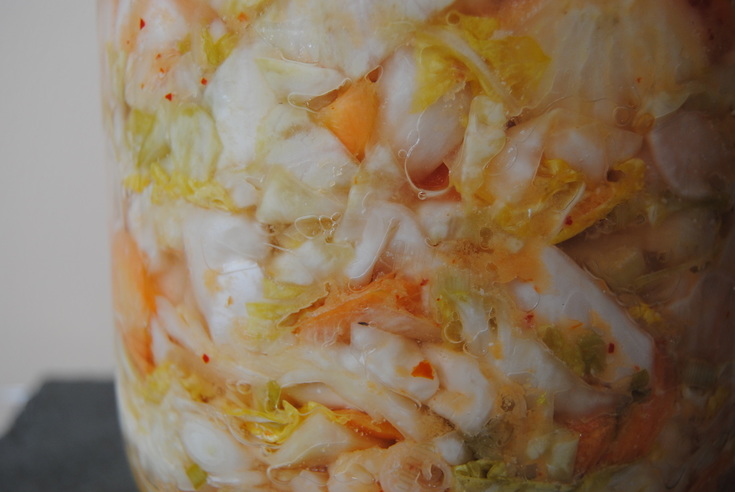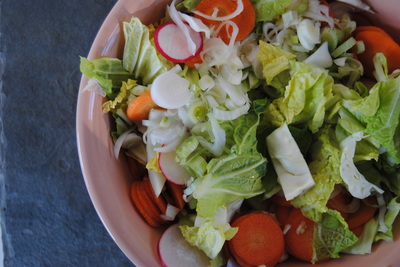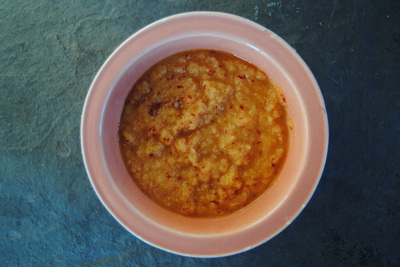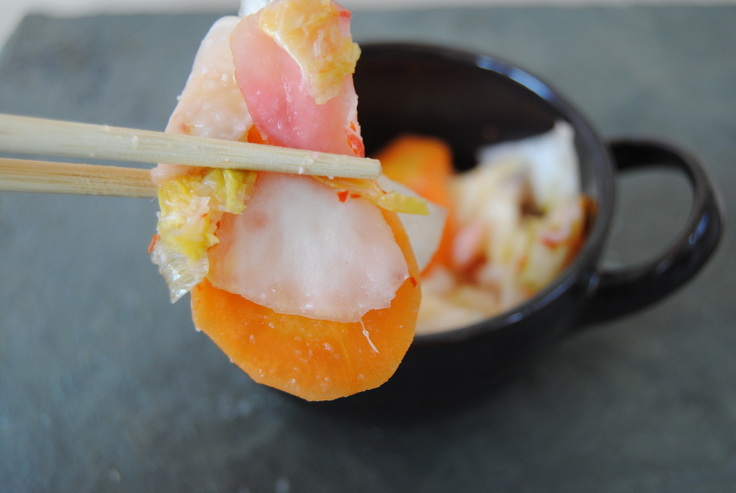|
As you can probably tell from following our recipes, we just love beautiful looking and delicious tasting foods. But almost more important than that we just adore foods that keep our gastrointestinal tracts (guts - the internal kind!) happy and healthy. Because good digestion is just one of those things that can really change your life if you've ever struggled with any sort of digestive issues. And it completely makes sense that what we put into our bodies day in and day out will create our internal environment and affect the happiness or unhappiness of our guts and digestion as a whole. With that being said, we have another fermented foods recipe for you this week, kimchi! Kimchi is a classic Korean fermented side dish made from vegetables and a combination of spices. Kimchi has long been known as one of the healthiest foods to consume because it is fermented. If you remember from these previous posts (learn more here and here), fermented foods are great for our guts because they contain live, active probiotic cultures, specifically lactobacilli. And even better that kimchi not only contains probiotics (good bacteria) but also contains prebiotics found in the green onion and garlic. Prebiotics are non-digestible carbohydrates found in certain foods and are necessary in the gut to feed the probiotics, which in turn creates that healthy gut environment we've been talking about! So we hope that by this post we've convinced you that fermented foods need to be in your diet ASAP, starting with this recipe... Basic Kimchi PREP TIME: 1.5 hours TOTAL TIME: 1.5 hours (+ 1 week fermentation time) Servings: 1 quart (4 cups) Ingredients 4 Tbsp sea salt dissolved in 4 cups water 1/2 pound Napa cabbage 1/2 pound green cabbage 4-6 red radishes 2 -3 large carrots 3 green onions 3 garlic cloves 4 dried red chili peppers 2 Tbsp fresh ginger root, grated 3 Tbsp rice flour Remove the outer layer of both the Napa and green cabbage and set aside. Roughly chop both cabbages and place in a very large bowl. Using a mandolin, or if you are able to do this by hand, thinly slice the radishes and carrots and place into the same bowl as the cabbage. Chop white and light green parts of the green onion and add to the bowl. Next make a brine using sea salt and warm water. Stir brine until salt has fully dissolved. Pour brine over prepared vegetables. Using your hands, gently massage the vegetable to help draw water out of the vegetables and completely coat in brine. Using a plate that fits nicely inside the bowl, place on top of the massaged vegetables and then add a weight on top of the plate (we used a jar filled with water). You basically want something heavy enough to fully submerge the vegetable under the brine. Allow to sit at room temperature for at least 1 hour. Now begin to make your flavor paste. In a high speed blender or a food processor, combine garlic, ginger, and chili peppers and add just a splash of water to allow mixture to come together in the blender. You should end up with a semi-chunky paste. Add 1 Tbsp rice flour to the paste at a time until a thick mixture has formed. The rice flour helps to thicken the paste so that it adheres to the vegetables. Once vegetables have soaked in the brine for at least 1 hour, taste test for desired level of salt. If you feel the vegetable are too salty, rinse them off. We thought the level of salt was perfect and therefore did not rinse. Drain off brine making sure to save the liquid in a separate bowl. Add drained vegetables to a new, large bowl and gently massage the vegetables with the chili-ginger-garlic paste until vegetables are completely coated. Now gradually add prepared vegetables to a large, sanitized glass jar or a crock. It is important to make sure you pack the vegetables down to allow for a tight "seal" which will prevent your kimchi from molding. Continue this process until all the vegetables are tightly packed into the jar. There should be at least a 4" space from the top of the jar and the vegetables. Pour enough reserved brine over vegetables until the top is fully submerged. Hint- you do not want to add too much brine to the jar because as the vegetables ferment they will release more liquid which could lead to a brine overflow! Place reserved full cabbage leaves over the top of the prepared vegetables pressing the edges tightly down the sides of the jar making a top seal over your vegetables. Place a clean jar filled with water or a fermentation weight on top of the cabbage leaves to apply pressure (pictured above). Remember, it is very important to make sure you have a tight seal to make sure your kimchi ferments properly. Place in a warm spot in your kitchen and let the fermentation begin! After about seven days, taste your kimchi. If desired flavor (tang, spice, and sourness) is to your liking then it's time to chill the kimchi. Remove top cabbage leaves and discard. Tightly pack kimchi and enough brine to submerge vegetables into air tight containers, cover with a lid, and place in the fridge. Note that large mason jars work well for fermentation jars and kimchi storage once fermentation is complete. If you've never had kimchi the flavor might surprise you at first - quite salty, tangy, spicy, and sour all at the same time in a special way that just well, works. And we can't say enough about how happy your gut will be if you get this (or other) fermented foods into your diet on a daily basis. We suggest enjoying kimchi over rice, in miso soup, diced up and mixed into cream cheese for toast or bagels, hidden in grilled cheese, or on top of Korean BBQ tofu tacos. Get creative with it and remember to tell us your favorite way to enjoy your kimchi!
Stay happy, Jess and Cecelia
0 Comments
Leave a Reply. |
AuthorsJess and Cecelia welcome you to our kitchen. We are fun-loving and passionate foodies working to make the world a healthier, happier place one plant based recipe at a time. Categories
All
Archives
December 2018
|








